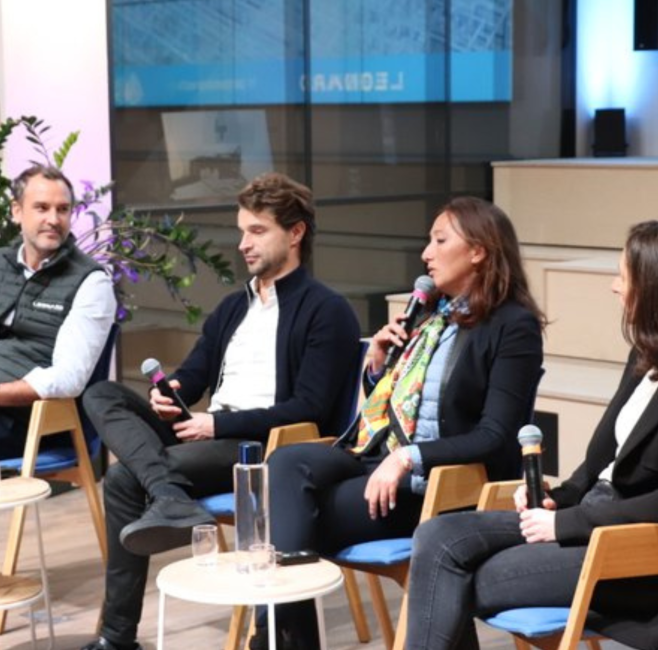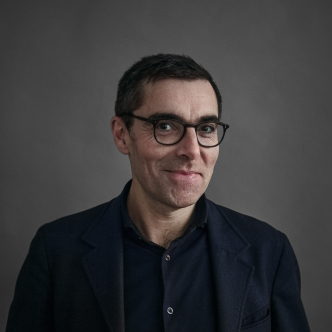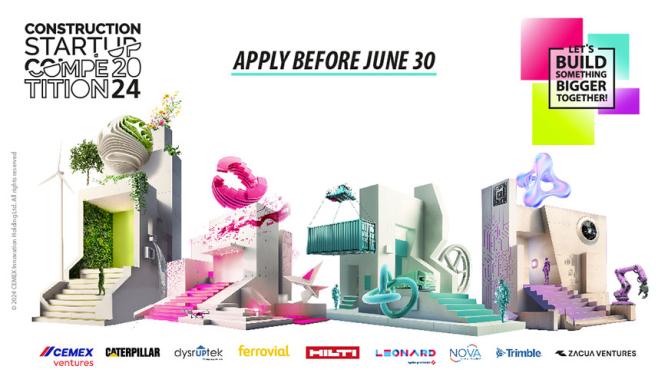The development of innovative materials is a valuable avenue for reducing the impact of the construction sector. Biosourced insulation, wood injected with synthesized resins, self-healing or energy-emitting materials…. These are just some of the technologies that are attracting growing interest from players in the industry. But how do we get “from the lab to the market? This was the theme of an event organized on November 22, 2023 by Leonard, the VINCI Group’s innovation and foresight platform. The debate brought together Marwan Aitomar and Alizée Blanchin, respectively deeptech consultant and partner director – consulting at Hello Tomorrow, Caroline Thaler, CEO of Bloomineral, Valentina Dipietro, co-founder and CEO of Mykor, Timothée Boitouzet, founder and CEO of Woodoo, Armelle Langlois, director of sustainable performance at VINCI Construction and Patrick Jouin, designer.
Introducing the debates, Marwan Aitomar and Alizée Blanchin outlined the second part of the report “The Future of Sustainable Construction: Innovation Materials”, co-produced with Léonard. This was an opportunity to point out that construction accounts for 40% of the world’s raw materials consumption, and building operation for 30% of final energy consumption.
Read our report « Pathways to sustainable concrete » (Leonard x Hello Tomorrow)
Or download the report here
“Faced with such challenges, there is no miracle solution. We need to activate as many levers as possible to exploit and seek to exploit the full disruptive potential of technologies”, asserted Alizée Blanchin. In her view, the materials issue should be considered from three angles: the availability of resources; construction and its consumption; the end-of-life of buildings and the potential for reusing materials.
Today, there are many new materials to mobilize: components with changing structures (thermo-chromatic glass, corrosion-detecting cements), piezoelectric materials, materials from the circular economy, biosourced materials, biomimicry-inspired materials (self-healing concrete, self-cleaning surfaces), and so on. These are just some of the potential allies on which a large number of deeptech companies are working today, at varying stages of development.
Natural resources
Research into these future building materials is largely based on the exploration of naturally-occurring resources such as minerals, wood, bamboo or mycelium.
British startup Mykor, a finalist in the Hello Tomorrow Global Challenge 2022 in the “Sustainable Construction and Infrastructure” category, has developed a technology – now patent-pending – for manufacturing insulation made from a variety of resources: biomass residues from the paper industry, mycelium or even green chemistry. “Operational carbon, i.e. carbon emitted during the operating phase of buildings, can be significantly reduced (by up to 80%) thanks to efficient structural insulation”, explains Valentina Dipietro, co-founder and CEO of Mykor.
Another material, another technology, another startup: Woodoo, a French deeptech founded in 2017 and winner of numerous awards, uses wood to manufacture a hybrid material capable of replacing glass, steel or concrete. “Wood is composed of cellulose and lignin. We selectively remove the lignin, a macro-molecule appreciated by insects and which degrades with air and humidity, to replace it with synthesized and recycled resins”, explained Timothée Boitouzet, founder and CEO.
As for Bloomineral, a company currently incubated by Marble, it has chosen to focus on biomineralization to decarbonize cement. “The idea is to use natural organisms present in seawater to capture CO2 and convert it into minerals and organic matter”, explains Caroline Thaler, CEO of the deeptech company.
Cooperation and conviction
As Timothée Boitouzet points out, maturation times in the deeptech market are long, much longer than in the digital sector.
But how do we get “from the lab to the market” ? All the speakers at the round table stressed the importance of collaboration between players in the ecosystem. “We need to learn to talk to each other and use the same language. Now it’s up to us to convince insurers, project owners and architects”, defended Armelle Langlois, director of sustainable performance at VINCI construction, which, as a turnkey company, monitors the market as exhaustively as possible and multiplies test benches to test the relevance of each new technology.
Designed to enhance the resilience of buildings, these new materials respond to a logic of circularity. “A building must be seen as a bank of materials. We need to build today so we don’t have to destroy tomorrow, by imagining disassembly scenarios for the future right from the design stage”, asserted Armelle Langlois.
A philosophy of sobriety endorsed by designer Patrick Jouin, known the world over for his work on urban furniture, who was invited at the end of the debate to explain the function of materials in design: “In designing objects, we work with as little material as possible. New technologies such as 3D printing enable us to remove material from objects. Even if we don’t always know what these objects are going to look like.”
Verbatim
Alizée Blanchin (Hello Tomorrow): “Seek to exploit the full disruptive potential of technologies.”
Valentina Dipietro (Mykor): “Operational carbon can be reduced by 80% through effective building insulation.”
Armelle Langlois (VINCI Construction): “A building should be seen as a bank of materials.”
Caroline Thaler (Bloomineral): “Biomineralization consists in converting CO2 into mineral and organic matter.”
Timothée Boitouzet (Woodoo): “We replace the lignin in wood with synthesized and recycled resins.”










